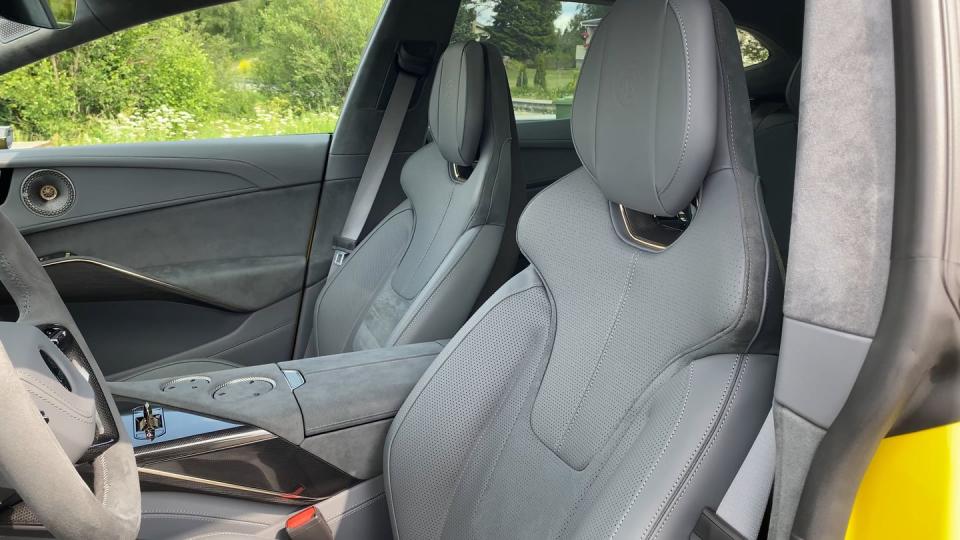The Lotus Eletre Isn’t Like Any Other Lotus

I’m sure you clicked on this link armed with a confetti cannon of criticisms and questions ready to be fired in the direction of anyone mentioning a Lotus SUV. You’re wondering about its weight, steering feel, and other qualities synonymous with the little British company’s little British cars. Your responses will range from curious to curses, with at least one of you speculating on the feelings of Lotus’ long-deceased founder Colin Chapman. The largest question among my peers and no doubt you readers: “Does it feel like a Lotus?” After two days, I think the answer is no, but that isn’t Lotus’ fault.
What struck me most at the Lotus Eletre press launch was the company’s ambitions. They mentioned some surprising numbers that caused my eyebrows to meet my hairline.
150,000: The number of cars Lotus wants sell in 2028
1,700: The number they sold in 2022
44: Total Lotus service centers in North America
2024: The year the Eletre will be delivered to customers
Ambitious.
Lotus has already begun to expand its dealership network to service all these new cars. That will be no easy feat, as first-attempt EVs often involve plenty of recalls and service bulletins, and the Eletre is as all-new as they come. Its powertrain, chassis, over-the-air-update system, and deployable radar system (Lotus says this “future proofs” it for Level 4 autonomy but provided no road map as to when that will be available. are all new. While it was designed in the U.K. at the Geely Design Studio in Coventry, the engineering and development was done in Germany and it will be assembled at the Lotus plant in Wuhan, China; Firsts for Lotus, obviously. Lotus has never made a 5-door car, a car with all-wheel drive, or fitted one with electric power steering, or made an EV bearing their name, and now it’s taking all of those leaps at once.

Those leaps all come thanks to a $2B investment into Lotus by Geely, a Chinese conglomerate that began life in 1986 as a refrigerator manufacturer. Geely quickly transitioned to making motorcycles and—in the early Aughts—cars. The Geely Automotive Group Division now includes 10 companies, of which Volvo and Polestar are the most known among Western audiences. Without this infusion of cash, it’s unlikely that Lotus’ trifling sales could have kept the company afloat for long in a world increasingly drawn to crossovers and emissions regulations, both of which put the sports car market as we know it at risk.
Hence, the Eletre, a five-door EV. Unlike Lotus’ previous cars it is neither light nor small. The 5700-lb Eletre could wear a Lamborghini Urus’ jacket nearly perfectly, so close in dimension are the two. On the powertrain front, both the Eletre and Eletre S have a 105-kWh battery pack feeding a 225-kw Permanent Magnet Synchronous motor at each axle producing a total of 441 kW (591 hp). Range is estimated at 373 miles. A 350-kW DC fast charger juices the Eletre from 10-80% in 20 minutes, thanks to its 800-volt architecture. Air suspension comes standard, while rear steer and active anti-roll are optional.

None of that sounds much like what you’d expect from a Lotus sports car. And the Eletre hardly looks like an Emira. Black is used at the top and bottom of the car in an effort to hide the vehicle’s size, but it’s not as effective as it is on the Mach-E. Transforming a sports car’s design into an SUV can’t be easy and I mean no disrespect to those given the task. Porsche does it right today but certainly had a few awkward years. However, unlike the Cayenne or even the Urus, I find it hard to even see the relation between the Eletre and its alluring siblings, the Emira and Evija.
However, the design is extremely functional. The Eletre’s drag coefficient is just.26, significantly lower than the Rivian R1S’ (.30), though still two one hundredths behind the Tesla Model X. Lotus accomplishes this in part thanks to its porous design. Walk around the car and you’ll see slats in the hood and portholes at the rear which let air pass through the car rather than over or around it. The lower grill hides electronically-actuated polygonal vents that open or close depending on cooling needs. There’s wings—both fixed and deployable—at the back which straighten the air and provide a little downforce, though they wouldn’t tell us exactly how much.

Open the door and you will see the most luxurious and well-appointed Lotus interior ever, and one that’s competitive among its peers. A sea of Re-Fiber (Lotus’ own premium fabric that’s made from fashion fabric waste) and Alcantara cover the doors, seats, arm rest, and steering wheel. I’m not sure I’d subject such a velvety environment to six months of shuttling children, but the first impression was a good one. Napa Leather is also available. The seats are supportive and comfortable and there’s plenty of legroom for every occupant. Visibility is fine. After 8 hours spread across two days I can say that the Eletre’s interior is a very comfortable and quiet place to be. That is unless you turn up the 23-speaker KEF Dolby Atmos stereo, which is the best automotive audio experience I’ve had to date. If it’s possible to play movies in the car (while parked), do it. Loud? Yes, but how else can we test the soundness of the interior’s construction? There wasn’t a buzz or rattle, no matter the volume. Audiophiles will enjoy it unless they want to tune the EQ themselves, because there’s no way to do that.


 Yahoo Autos
Yahoo Autos 